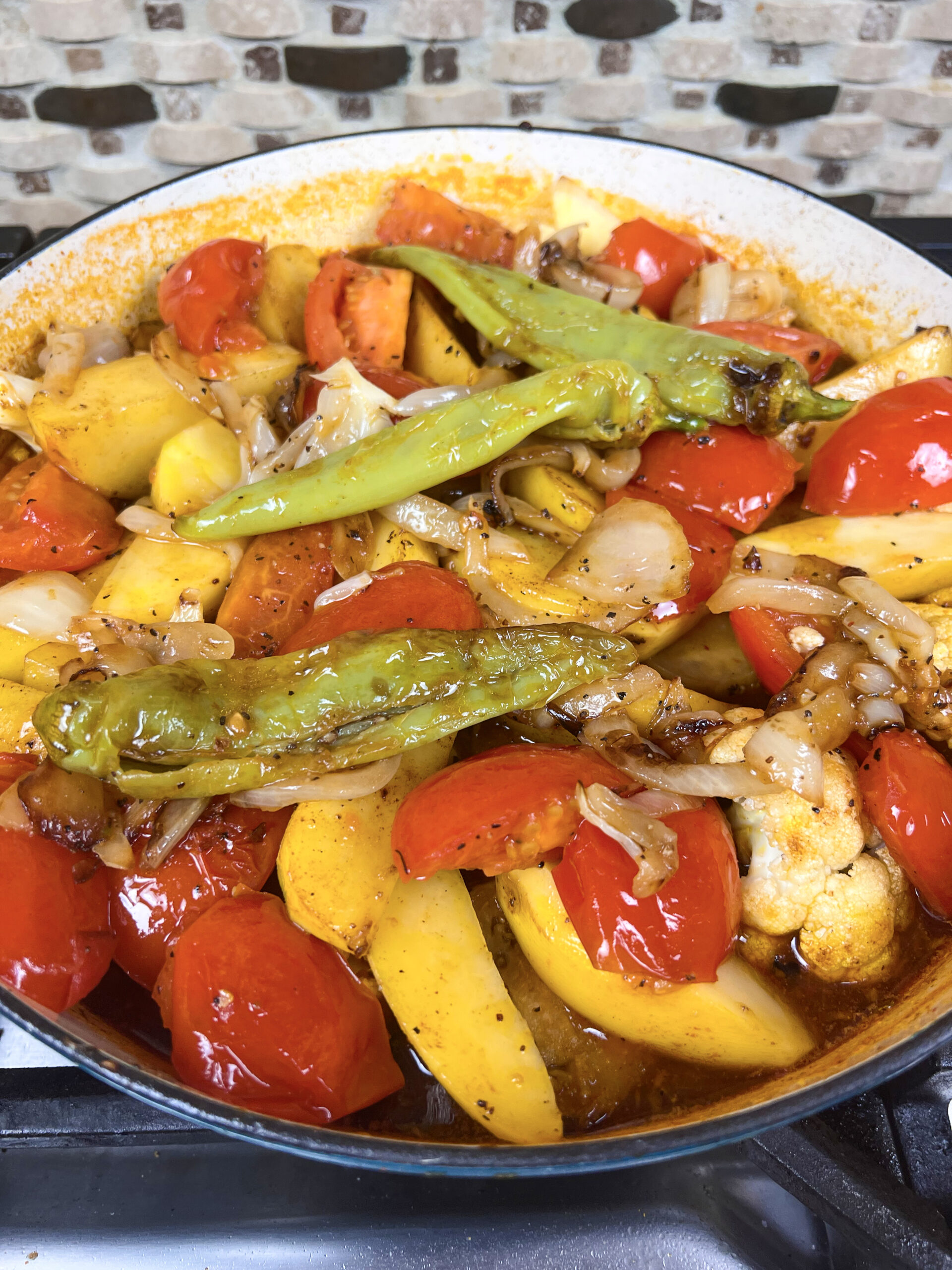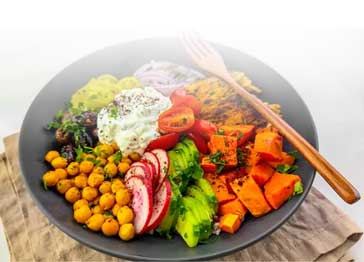This Greek roasted vegetable dish, known as Briam, is simple, comforting, and full of Mediterranean flavor—perfect for any night of the week.
Briam is one of those simple Greek dishes that feels like a hug from the Mediterranean. Think roasted eggplant, zucchini, potatoes, and tomatoes—layered together, drenched in olive oil, and slow-baked until everything melts into pure flavor.
It reminds me so much of the vegetable dishes my mom used to make during Lent, similar to the Middle Eastern khaddar. Just like those meals, Briam is wholesome, comforting, and full of good-for-you ingredients. Whether you serve it as a main with crusty bread or a side with grilled fish or chicken, it’s a beautiful way to celebrate seasonal vegetables and the heart of the Mediterranean diet.
Ingredients
Vegetables:
- Japanese Eggplants or Regular Eggplant (Sliced in Circles): Mild and slightly sweet, the eggplants contribute a tender texture to the stew.
- Large Potatoes: Hearty and starchy, the potatoes add substance and a creamy texture to the stew.
- Roma Tomatoes (Ripe): Sweet and tangy, ripe tomatoes bring a burst of freshness to balance the richness of the stew.
- Large Onion (Cut into Strips): The savory and slightly sweet onions create a robust base for the stew.
- Banana Peppers (or Any Mild Pepper): Mild heat with a subtle sweetness, banana peppers contribute a gentle kick to the stew.
- Garlic Cloves (Minced): Pungent, aromatic, minced garlic adds depth and complexity to the overall taste.
- Olive Oil: The fruity richness of olive oil enhances the stew’s overall depth and mouthfeel.
- Salt and Pepper to Taste: Balances and elevates the flavors of the vegetables, ensuring a well-seasoned stew.
Stock:
- Water Base: Provides the liquid foundation for the stew.
- Sweet Pepper Paste: Sweet and mildly spicy, pepper paste enriches the stew with depth and complexity.
- Tomato Paste: Intensifies the tomato essence, adding a rich umami note to the stew.
- Curry and Turmeric: Earthy and warm, curry and turmeric bring a vibrant color and distinctive flavor to the stew.
- Cardamom: Warm and aromatic, cardamom introduces a hint of sweetness and spice.
- Salt and Pepper to Flavor: Seasoning the stock ensures a well-balanced and savory base for the vegetable stew.
The Signature Sauce
The heart of Briam is its sauce, rich, flavorful, and deeply comforting. It starts with tomato paste and red pepper, bringing depth and warmth, much like the Middle Eastern khaddar I grew up with. But this version gets an extra layer of flavor from cumin, turmeric, and a touch of Aleppo pepper. And of course, plenty of garlic for that earthy, irresistible aroma.
This sauce doesn’t just coat the vegetables—it brings the whole dish together. It’s so good, you’ll want to scoop it up with warm pita or pour it over rice. Try it with lemon Greek rice, rice vermicelli, or even Yemeni rice to soak up every last drop.
Tips for Perfecting Briam
- Size Matters: The size of the vegetable pieces is crucial. Medium-sized chunks are ideal. The vegetables might lose their integrity during baking if they’re too small. If it is too large, extended cooking time may be needed. Aim for tender, flavorful pieces that maintain their shape.
- Salting and Seasoning: To enhance flavors and facilitate cooking, start by individually salting and seasoning each vegetable type before combining them. Start lightly dressing each vegetable with olive oil, then sprinkle with salt and pepper. This careful approach softens the vegetables and expedites their cooking time, guaranteeing each piece is perfectly cooked and seasoned just right. This practice brings out the unique taste of each vegetable, contributing to the dish’s complex flavor profile.
- Quality of Ingredients: Using high-quality, fresh ingredients is essential. Since Briam is a simple dish, the vegetables and olive oil flavors stand out prominently. Choose ripe, in-season vegetables and a good quality olive oil for the best results.
Leftover Ideas
- Briam Soup: Transform your leftover Briam into a comforting soup! Blend the veggies with some vegetable or chicken broth until smooth, then warm it up. Adjust the seasoning, and serve with a dollop of yogurt or a sprinkle of fresh herbs.
- Briam and Egg Scramble: Chop the leftover Briam into smaller pieces for a quick and hearty breakfast. Then, scramble it with some whisked eggs. Cook until the eggs are set and you have a vegetable-packed start to your day.
- Briam Frittata: Another breakfast option is to mix the chopped leftovers with beaten eggs and bake until set for a tasty and nutritious frittata.
With these options, you’ll minimize waste and enjoy your delicious Briam in various ways! Feel free to get creative and experiment with different ideas to repurpose your leftovers.
Step-by-Step Instructions
Make the Flavorful Stock

Cook the Vegetables


Continue in batches with the potatoes, tomatoes, cauliflower, and peppers, seasoning each batch with salt and pepper as you go. Add more olive oil as needed between batches to keep the vegetables from sticking or drying out.
Prepare the Oven & Sauté Aromatics

Assemble & Bake

Bake uncovered in the preheated oven at 375°F for about 1 hour, or until the vegetables are tender and the sauce has thickened slightly.
Broil & Serve

Once the top is golden and slightly crisp, remove from the oven and let it cool slightly before serving.
Ingredients:
| 2 Japanese eggplants, cut into 1-inch circles | |
| 3 large potatoes, cut lengthwise into 4 pieces each | |
| 5 Roma tomatoes, ripe, cut lengthwise into 4 pieces each | |
| 1 large onion, cut into strips | |
| 3 banana peppers (or any mild pepper of your choice) | |
| 15 garlic cloves, minced | |
| ½ cup olive oil | |
| Salt and pepper to taste |
For the sauce
| 3 cups water or vegetable stock | |
| 1 tablespoon sweet pepper paste | |
| 2 tablespoons tomato paste | |
| 2 teaspoons curry powder | |
| 2 teaspoons turmeric powder | |
| 2 teaspoons ground cardamom | |
| Salt and pepper to flavor |
Preparation
In a medium saucepan over medium heat, warm 3 cups of water. Stir in the sweet pepper paste and tomato paste until fully dissolved. Add the curry powder, turmeric, and cardamom, then season with salt and pepper to taste. Once everything is combined, remove from the heat and set aside.
Heat a few tablespoons of olive oil in a Dutch oven over medium-high heat. Start with the eggplant, cooking for about 2 minutes per side until the edges soften. Season with salt and pepper, then transfer to a platter. Continue in batches with the potatoes, tomatoes, cauliflower, and peppers, seasoning each batch with salt and pepper as you go. Add more olive oil as needed between batches to keep the vegetables from sticking or drying out.
Preheat your oven to 375°F. Using the same Dutch oven, heat any remaining olive oil over medium heat. Add the sliced onions and sauté for 3 minutes until softened. Then stir in the minced garlic and cook for another 2 minutes, just until fragrant.
Pour the prepared stock over the sautéed onions and garlic in the Dutch oven. Gently arrange the partially cooked vegetables on top, layering them evenly. Bake uncovered in the preheated oven at 375°F for about 1 hour, or until the vegetables are tender and the sauce has thickened slightly.
Turn on the broiler for the last 3–5 minutes to lightly caramelize the top of the vegetables. Keep a close eye to prevent burning. Once the top is golden and slightly crisp, remove from the oven and let it cool slightly before serving.
Recipe Tips & Suggestions
Storage Instructions:
Reheating Instructions:
Nutrition Information
The information shown is an estimate provided by an online nutrition calculator. It should should not be considered a substitute for a professional nutritionist's advice.
See our full nutrition disclosure here.







Have you tried making Briam, or do you have a twist on this Greek classic? We’d love to hear from you! Leave a comment below sharing your experience, thoughts, or suggestions. Let’s get the conversation started!